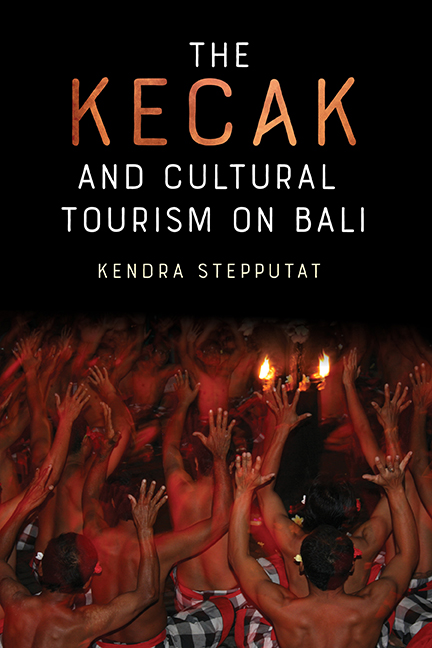Book contents
- Frontmatter
- Contents
- Acknowledgments
- Note to the Reader
- Introduction
- Part 1 The Present
- Part 2 The History
- Appendix 1 Kecak dan Wisata Budaya di Bali (Indonesian Summary)
- Appendix 2 Kecak Groups of Bali in 2000–2001 (Badung and Gianyar)
- Appendix 3 Facsimile of a Letter from Walter Spies to Leo Spies, 1932
- Glossary
- Bibliography
- Index
3 - Kecak: The Drama
Published online by Cambridge University Press: 07 October 2022
- Frontmatter
- Contents
- Acknowledgments
- Note to the Reader
- Introduction
- Part 1 The Present
- Part 2 The History
- Appendix 1 Kecak dan Wisata Budaya di Bali (Indonesian Summary)
- Appendix 2 Kecak Groups of Bali in 2000–2001 (Badung and Gianyar)
- Appendix 3 Facsimile of a Letter from Walter Spies to Leo Spies, 1932
- Glossary
- Bibliography
- Index
Summary
From the middle of the twentieth century to the beginning of the twentyfirst, a standard kecak performance by most sekaha cak in the tourist business on Bali followed the “Kepandung Sita” plot. This is an abbreviated version of the Indian epic Ramayana (Rāmāyaṇa) and focuses on the core storyline and characters of the epic. In 2000 and 2001, seventeen groups performed this compact version of the Ramayana. In the years that have followed, several groups have abandoned this plot and adapted other parts of the Ramayana story while maintaining the core cast and topic.
The Ramayana is one of the two Indian epics (the other being the Mahabharata) that provide the basis for most of the content for dramatic performances in many Balinese genres. Which parts of the Ramayana are used and how they are adapted into a kecak performance has changed significantly since the earliest kecak performances. Early performances focused on episodes and secondary characters, for instance the fight between the two rival monkey brothers Subali and Sugriwa, or the side story of the death of Rahwana's younger brother Kumbakarna. Both of these plots were performed in the village of Bedulu. The main storyline of the kecak version performed in the village of Bona was the abduction of Sita, which probably served as the model for all standard tourist kecak performances developed later. The kecak ramayana established in the 1960s is a fascinating mix of genres as well as a very distinct form of dramatic dance performance. To understand the particularities of kecak ramayana as a dramatic performance, it is important to look into the adaptation of the Ramayana as it entered both Balinese culture and the kecak. Further, I explore the main elements of Balinese dance drama in comparison to Euro-American (“Western”) staged dramatic performances.
The core of this chapter is a detailed description of one particular kecak ramayana performance. Each scene is commented on separately, connecting the analysis to the performance elements. The comments that are added to the rendition of the kecak dance drama are explicitly comparative. The analysis looks at the kecak performance from the perspective of a tourist audience, not only as a description of what it is but also as an analysis of what it appears to be to a tourist observer. This comparative approach is applied in order to understand the adaptation process and the resulting compromise that is kecak.
- Type
- Chapter
- Information
- The Kecak and Cultural Tourism on Bali , pp. 86 - 124Publisher: Boydell & BrewerPrint publication year: 2021



